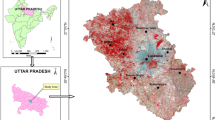Abstract
The quality of surface and groundwater are fundamental concerns. The World Health Organization (WHO) reports that 80% of diseases are waterborne. This percentage mostly lies in developing nations and underdeveloped countries. Determining the relationship between land-use patterns and groundwater quality changes is one of the methods to evaluate the impact of land-use on the hydrological condition of each region which ultimately assists in managing natural resources. In the present study, the spatial–temporal model via satellite images of Landsat TM, ETM, and OLI for2002, 2007, 2012, and 2017 are used to investigate all these modalities in Shahriar Plain, Tehran, Iran. Following image processing and analysis, the land-uses of the study area are classified into urban, farming, and bare lands. In order to assess the water quality of the study area, the periodic sampling data of piezometric wells in the plain were used from 2002 to 2017. Based on the US Salinity Laboratory (USSL) diagram, water qualities for agricultural uses are classified. Results demonstrated that land area has changed over time indicating an increase in urban land area and declines in agricultural and bare lands. Additionally, the results of the groundwater quality indicated C3S1 class in the second and third periods have increased to 3.58% (1025.93 ha) and 12.82% (9367.85 ha) while C2S1 class has been decreased in second and third periods to 3.58 and 12.82%. C1S1 and C4S1 classes during the three periods have been 0.







Similar content being viewed by others
Availability of data and materials
The data supporting the findings of this study are available from the corresponding author upon request.
References
Acharya, S., Sharma, S., & Khandegar, V. (2018). Assessment of groundwater quality by water quality indices for irrigation and drinking in South West Delhi, India. Data in Brief, 18, 2019–2028.
Akbari, M. (2016). Proposing an early warning system for desertification hazard: Case study of semi desert region of the Organ Plain, Golestan Province. Gorgan University of Agricultural Sciences and Natural Resources, Gorgan, Iran.
Böhlke, J.-K. (2002). Groundwater recharge and agricultural contamination. Hydrogeology Journal, 10(1), 153–179.
Ejlali, F., Asgari, A., & Dehghani, M. (2016). Evaluation of groundwater quality in Caspian Coastal areas for agricultural consumption and application for drip irrigation systems. Journal of Irrigation and Water Engineering, 25(7), 97–109.
Eskandari Damane, H., Zehtabian, G., Salageghe, E., Ghorbani, M., & Khosravi, H. (2018). The Impact of Land Use Changes on the Quantity and Quality of Groundwater Resources of West Jazmourian Basin. Iranian Journal of Natural Resources: Rangeland and Watershed Management., 3(71), 563–578. https://doi.org/10.22059/JRWM.2018.257186.1259
Fallah-Alipour, S., Mehrabi Boshrabadi, H., Zare Mehrjerdi, M. R., & Hayati, D. (2018). A framework for empirical assessment of agricultural sustainability: The case of Iran. Sustainability, 10(12), 4823.
Hosseini, A., Poormohammad, P., & Yarmohamadi, E. (2018). Survey of groundwater quality in irrigation networks with agricultural and urban purposes; Case study of Dasht Abbas. Iran. Iranian Journal of Watershed Management Science and Engineering., 40(12), 51–59.
Khaje, M., Bazrafshan, A., Vagharfard, H., & Esmaiel Pour, Y. (2014). Quantitative and qualitative survey of groundwater in Parishan Plain. Iran. Journal of Space Planning and Preparation., 4(18), 71–96.
Khan, H. H., Khan, A., Ahmed, S., & Perrin, J. (2011). GIS-based impact assessment of land-use changes on groundwater quality: Study from a rapidly urbanizing region of South India. Environmental Earth Sciences, 63(6), 1289–1302.
Khodai, K., Shahsavari, A., & Etebari, B. (2006). Evaluation of Jowin groundwater changes using Drastic and Gods methods. Iranian Journal of Geology, 2(4), 73–87.
Mei, K., Liao, L., Zhu, Y., Lu, P., Wang, Z., Dahlgren, R. A., et al. (2014). Evaluation of spatial-temporal variations and trends in surface water quality across a rural-suburban-urban interface. Environmental Science and Pollution Research, 21(13), 8036–8051.
Mirzaeei, M., Solgi, E., & Salman Mahini, E. R. (2016). Investigating the relationship between water quality parameters and land use changes. Water Management and Irrigation, 2(6), 175–192.
Nasrollahi, M., Mombeni, M., Valizade, S., & Khosravi, H. (2014). The impact of land use / land coverage trend on groundwater resources status using satellite images; case study: Gilan gharb plain. Journal of Geographical Information (SEPEHR), 91(23), 89–97.
Oorkavalan, G., Chidambaram, S. M., Mariappan, V., Kandaswamy, G., & Natarajan, S. (2016). RETRACTED: Cluster Analysis to Assess Groundwater Quality in Erode District, Tamil Nadu. India. Circuits and Systems, 7(6), 877–890.
Pawar, R., Panaskar, D., & Wagh, V. (2014). Characterization of groundwater using water quality index of solapur industrial belt, Maharashtra. India. Int J Res Eng Technol, 2(4), 31–36.
Abbad, R. S., & J., Zehtabian, G. R., Khosravi, H., & Gholami, H. . (2016). Survey of Land Use Changes Trend on Groundwater Quality in Yazd Plain, Ardakan. Iran. Journal of Geography, 1(7), 189–199.
Sadeghi, A., Zehtabian, G. R., Malekian, A., & Khosravi, H. (2014). The Impact of Land Use Change on Groundwater Quality in Zarifar Lake Watershed. Watershed Research, 105, 90–97.
Salehi, H., & Zeinivand, H. (2014). Evaluation of groundwater quality for drinking and agriculture and selection of the most appropriate spatial mediation method.153–166:(3)1. Journal of Wetland Ecobiology, 3(1), 153–166.
Todd, D., & Mays, L. (2005). Groundwater Hydrology,‖ Third Edition. John Wiley and Sons, Inc.
Fao.org. (1985). Water quality for agriculture. [online] Available at: http://www.fao.org/3/T0234E/T0234E01.htm#ch1.4. Accessed 3 April 2021.
Funding
No fund was received for the present study.
Author information
Authors and Affiliations
Ethics declarations
Consent for publication
All authors have reviewed the paper and provided consent for publication.
Conflict of interest
All authors declare that they have no conflict of interest.
Additional information
Publisher's Note
Springer Nature remains neutral with regard to jurisdictional claims in published maps and institutional affiliations.
Rights and permissions
About this article
Cite this article
Rostammiri, A., Malmasi, S., Yosefvand, F. et al. Presenting the spatial–temporal model for assessing and predicting qualitative changes of the groundwater resources in Shahriar, Tehran, Iran. Environ Monit Assess 194, 31 (2022). https://doi.org/10.1007/s10661-021-09512-1
Received:
Accepted:
Published:
DOI: https://doi.org/10.1007/s10661-021-09512-1




